
|
We have so far considered bicyclists as victims, but is this really the case? Not always.
One main reason is, as explained in Fig. 8, that the bicycle can become the "perpetrator" when colliding with a pedestrian who suffers far more severe damage. Using accident case data collected by ITARDA, the second reason is examined below−certain behavior demonstrated by bicycle riders can induce traffic accidents and cause trouble for other road users.
(1) Often ignoring traffic lights and stop signs
Figure 15 provides the proportion of bicycle riders and vehicle drivers (four-wheeled vehicles plus motorcycles) (excluding walkers) who had ignored traffic lights or stop signs at the time of the accident. The rate is more than doubled for bicycle riders. In particular, the frequency of ignoring stop signs increases twofold compared with that for ignoring traffic lights. Many people might see their bicycle not as a vehicle but as some sort of pedestrian, or just a convenient "tool" for greater mobility than walking.
|
|
|
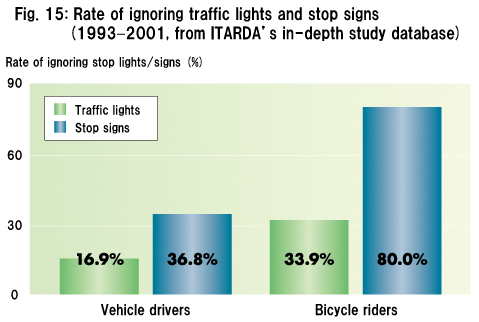
|
|
(2) Lane-changing without giving a signal, failing to turn on the bicycle light, traveling in an inappropriate manner, etc.
Characteristic behavior of cyclists other than ignoring stop lights/signs is summarized in Fig. 16.
(i) Lane-changing and turning left/right without giving a signal
It was confirmed that bicycle riders give virtually no signal when changing lanes or turning left/right.
Of the 55 accident cases used for the present analysis in which bicycle riders should have given some signal before changing lanes, a signal was actually given in only one case. Signals are given to ensure that other vehicle drivers are aware of the cyclist's intention and prepared for the action signaled. Signals are also useful for the bicycle rider to allow time to look around and confirm safety before changing lanes, etc.
(ii) Failing to turn on the bicycle light
About 20% of bicycle riders did not turn on their light at nighttime as required. A non-lit bicycle with the rider wearing dark clothes is at great risk at night. The purpose of turning on the light is to ensure that the bicycle is easily seen by others, rather than to improve the cyclist's vision. There are various ways to fulfill this purpose other than the bicycle light, such as installing a flashing light or a reflector.
|
|
|
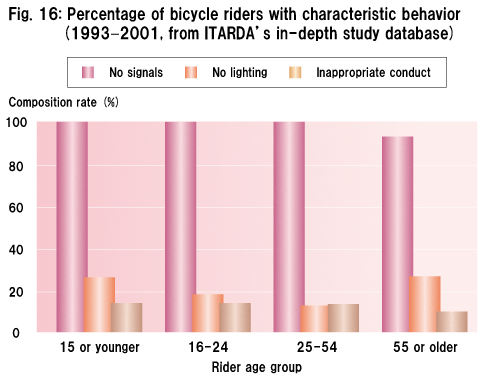
|
|
(iii) Traveling in an inappropriate manner, etc.
A little more than 10% of bicycles were ridden on the right-hand side of the road, made big turns or took a shortcut at an intersection, and presented other inappropriate behavior.
Figure 17 depicts a bicycle ridden on the right-hand side of the road (Bicycle R) at a rightward bend, with a higher possibility of colliding with a vehicle coming from the right compared to Bicycle L traveling on the left-hand side. Since oncoming vehicles usually stay on their left side of the road in Japan, Bicycle R cannot see an oncoming vehicle at a blind bend (leftward bend, from the view of the approaching vehicle) until it proceeds along the road by distance amount D.
|
|
|
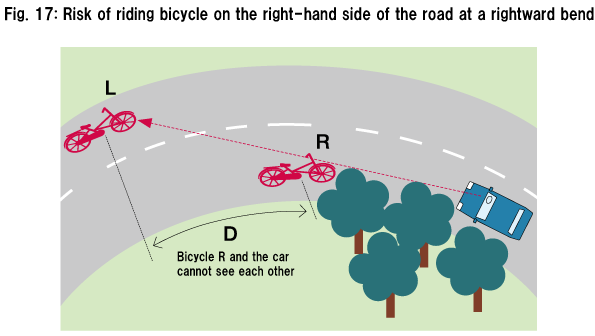
|
|
Another example of the risk of a bicycle keeping to the right-hand side of the road at a blind intersection is shown in Fig. 18. Motor vehicles usually stay on the left-hand side of the road in Japan. The distance at which a car spots Bicycle L is longer than that for spotting Bicycle R, giving the driver more of a chance to avoid a collision.
|
|
|
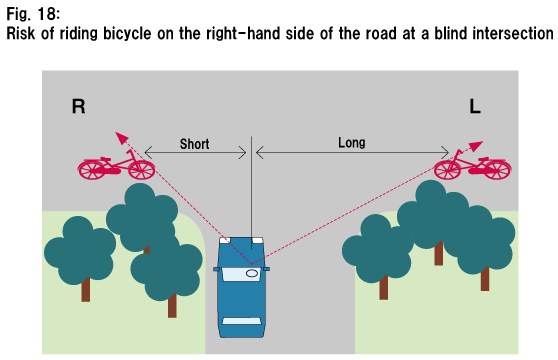
|
|
The risk of making a big turn or taking a shortcut at an intersection is exemplified in Fig. 19. By such cornering, the bicycle may enter the path of the oncoming vehicle and crash into it. The main reason for making a big turn or taking a shortcut at a corner is speeding on the part of the bicycle. It is much safer for a bicycle to sufficiently reduce speed at a corner.
While bicycles are said to be victims when hit by a four-wheeled vehicle or motorcycle, in many cases they could also be blamed for ignoring traffic lights/stop signs, lane-changing without giving a signal, failing to turn on the bicycle light, traveling on the right-hand side of the road, etc.
|
|
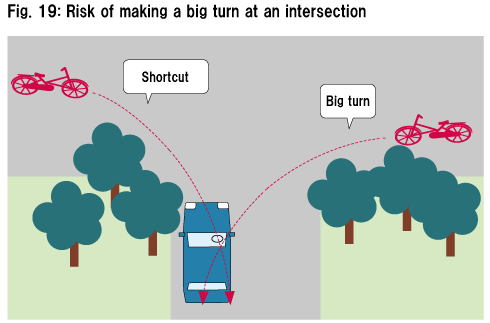
|
|
|
|
UP
Back
|
